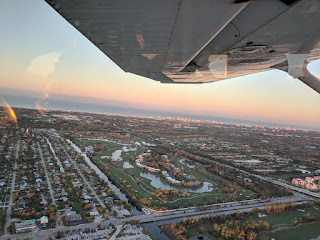We are starting to see Wood Storks in the area, and are anxiously awaiting their nesting. This once endangered indicator species is now the focus of many conservation efforts statewide.
Here at Corkscrew, we have a few different surveys geared towards Wood Storks. Our very intensive fish sampling days are intended to document the prey base for many wading birds, including the Wood Stork. For these surveys, we document the amount of fish, diversity of fish (how many different species there are), and mass of the fish in a given area. These surveys are completed throughout the dry-down period when fish start to conglomerate in the few pools of water that remain throughout the dry season.
Just recently, we completed our first flight for the season over parts of southwest Florida to monitor Wood Stork nesting. I have never flown in anything besides a commercial aircraft, so the small 4 person Cessna was quite a shock! The days leading up to the flight were filled with anticipation. I have heard friends, colleagues, and professors talk about some of the good and bad things about flight surveys. A stomach of steel is highly desired, but most people don’t know if they have one or not, until their first flight. So this was going to be the day that I found out if aerial surveys were in my future.
(Hopping aboard our aircraft)
I prepared by bringing light snacks to eat when going from point to point, and a Sprite to settle my stomach in case I was to find out I don’t have that desired “stomach of steel”. I was also told that it usually gets really warm in the air but when we open the windows to take pictures we get some nice fresh air. Well, this seemed to be a very atypical flight for Southwest Florida. We got to the Naples Airport by sunrise and the temperature was still in the 40’s! Luckily I was prepared for cold weather, I had my ski socks on, a long sleeve and sweatshirt, but I still needed more! Once we got up in the air and opened the windows, as promised, the cold wind came in to the already cool aircraft, and now we were freezing. Luckily the 360 degree views surrounding us were a great distraction.
(An aerial view of Naples development)
After rows and rows of houses and development, suddenly we came to an island of Cypress and greenery. We saw marsh, pines, cypress, and finally the boardwalk, with no houses to be seen. It was such a wonderful sight- a sight I’m sure would have been even more amazing years ago when this island of greenery was more like an ocean. But for now, the island of protected lands managed and cared for by many different agencies and organizations will suffice.
(The island of protected land, green for as far as the eye can see)
We traveled to different predetermined points from the Caloosahatchee River to Corkscrew. Once we got to a point, we would circle the area to determine if there was any Wood Stork activity and if there was where they were located. At our first point of the day, we found Wood Storks high in the canopy of the Cypress. I was amazed at the ease of seeing these majestic birds – seemingly unbothered – from the air. We locked down on the storks circling tighter to get the best, closest, clearest pictures possible while almost sitting parallel to the earth’s surface and bouncing around in the wind.
Once we got the OK that the photos came out clear enough, we were on to the next 4 more points. The views were always changing, back into civilization, then over water, circling small desert islands, watching Great Blue Herons flush from one island, and Great Egrets continue their day on another. But one thing was constant; the turbulence. The bouncing around and prolonged periods of circling one area led to a feeling in my stomach that was not promising.
(A small island in the Caloosahatchee with what was though to be nesting Great Egrets)
After an hour and a half of going from point to point, circling many different areas, it was time to go back to the airport. On the way back, the pilot took us up higher where the air was calmer leading to a more pleasant flight. Through our headset I heard the pilot say, “that was a rough flight! That felt like flying in New England, not Florida!” Hearing this, I have hope that the next flight will be even better, and maybe I don’t have a stomach of steel, but maybe it’s not too bad.
What's next on the adventure?
-Kelsie (Research Intern)





No comments:
Post a Comment